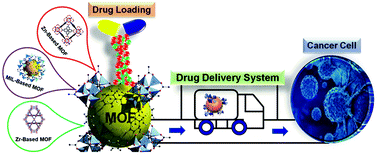The impact of MOFs in pH-dependent drug delivery systems: progress in the last decade
Abstract
Metal–organic frameworks (MOFs) are porous crystalline materials consisting of one-, two-, or three-dimensional networks created by metal ions/clusters and multidentate organic linkers through coordination bonding. MOFs are one of the most favorable candidates for biological applications such as wound dressings, cardiac prosthesis, tissue engineering, bioimaging, and drug delivery and as cancer theranostic systems due to their high surface area and porosity for the high loading of therapeutic agents and facile modification of their physical (e.g., pore size and shape) and chemical properties. Drug delivery involves the administration of drugs using a suitable carrier for achieving treatment without unwanted side effects. In the last few years, several types of MOFs have been synthesized including Zn-based MOFs, MIL series MOFs, and Zr-based MOFs and evaluated for their use in different biomedical fields, especially drug delivery. After Fe, zinc is the second most available element in the body, and hence Zn-based MOFs can be considered enduring platforms for various biomedical uses, especially drug delivery applications. MIL series composites and Zr-based biomaterials are also suggested for several biomedical applications due to their good mechanical properties, biocompatibility, and bioactivity. This review highlights the different types of Zn-based and MIL series MOFs that have been used as suitable pH-responsive drug delivery systems and summarizes the Zr-based MOFs that have been used as suitable pH-responsive or reverse pH-responsive drug delivery systems and also discuss their drug-releasing phenomenon at different pH ranges.

- This article is part of the themed collections: 2022 Frontier and Perspective articles and Spotlight Collection: MOF Sensors


 Please wait while we load your content...
Please wait while we load your content...